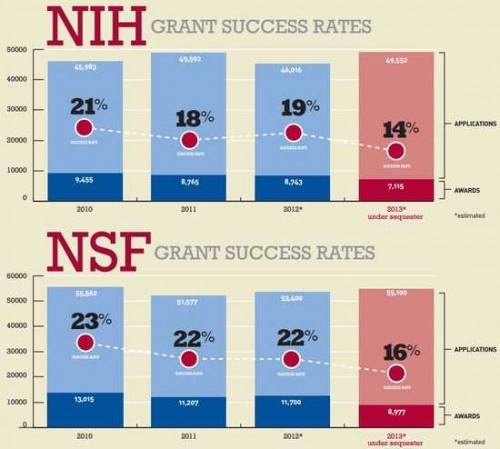
On March 1, 2013, the federal budget sequestration went into effect, implementing the automatic spending cuts that the Budget Control Act of 2011 had created two years ago. This fiscal year, reductions across the board will total approximately $85.4 billion, with a $9.3 billion decrease in federal R&D funding alone.
While the cuts spare no public sector, medical research is among the hardest hit. The National Institutes of Health, the largest financier of biomedical research in the world, was forced to make a five percent ($1.7 billion) budget cut by the end of September. It expects to fund only 15 percent of proposals received this fiscal year, a historic low from down from its peak of 37 percent in 2001. Defunding such vital research and development may threaten the quality of human health, curtail training of the next generation of researchers, and jeopardize the United States’ position as one of the world’s leaders in science research.

A nationwide survey conducted by the American Society for Biochemistry and Molecular Biology (ASBMB) asked more than 3,700 scientists across a wide range of disciplines about the effects of the sequester on their research. 80 percent of respondents indicated that they spend more time writing grants compared to 2010, while 67 percent receive less total grant money than before. “The biggest time commitment now for investigators is trying to get funding,” said Dr. Paul Lombroso, Director of the Laboratory of Molecular Neurobiology at the Yale School of Medicine. Dr. Lombroso also highlighted the dramatic increase in competition, with many outstanding proposals competing for fewer funds. With less time and fewer resources devoted toward conducting research, projects that have been underway for years may be forced to end.
Because sequestration has only existed for several months, the short-term effects have not been too substantial, as both major agencies and individual researchers report having a slight cushion of funding for the time being. But it is the future of science research that looks solemn if sequestration continues.
The lack of grant money will also affect jobs, with many researchers unable to hire new staff or even keep current lab members. Meanwhile, in a time of general economic austerity, foreign governments including those of the United Kingdom, Sweden, and Australia, among others, have committed funds and political backing to science. Thus, current and future researchers in the United States may soon have to make important choices. Faced with ongoing funding shortages, they may choose to leave the country for greener pastures — those nations with money for research funding, and perhaps more importantly, job security.

With dwindling job opportunities, the possibility of a so-called “brain drain” is becoming more of a reality. Eighteen percent of respondents in the ASBMB survey considered continuing their careers in another country, where research jobs are more stable. For others who have yet to select a career path, the prospect of science research has lost some of its appeal, and the number of students who enroll in graduate programs each year has declined sharply. As a result, projects with the potential to change the lives of citizens across the country and around the world may not be fully realized. With the threat of scientists leaving the United States and the risk of students defecting to other, more stable professions, the position of the United States’ leverage in science is precarious.
In light of federal funding cuts, researchers have turned to other tactics to obtain money. Researchers can seek “bridge funding” to tide themselves over, and some have resorted to especially creative means. HIV researcher Yuntao Wu of George Mason University is receiving money from an online charity drive set up by a non-profit organization. But Wu, like some other desperate colleagues, has also taken out a $35,000 personal loan to keep his lab open and continue the projects that he has worked on for years. For others like Wu, options are decreasing all around and the state of future science research in America remains unknown.
In light of the government shutdown on October 1, the sequestration will remain in place until Congress passes a new budget that explicitly redefines agency funding. While sequestration is hurting science now, the impact will be much greater in future years if these cuts in research funding continue and researchers must continue and perhaps even intensify their austerity. It remains to be seen if America’s quality of research will remain at its influential level if money is not there to support it.
